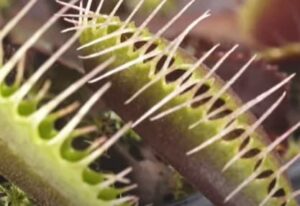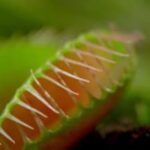As an Amazon Associate, this site earns commissions from qualifying purchases. For more details, click here.
So you just noticed there is a long stem growing on your Venus flytrap, what could it be? Is this stem important for the plant or should you remove it right away? If you are new to Venus flytraps, the information here can definitely help you decide what to do.
A growing stem or stalk means your Venus flytrap is about to flower. You should cut the stalk when it is about 2 inches high because flowering uses a lot of energy and will slow plant growth.
Do All Venus Flytraps Have Stems?
Venus flytrap stalks are green in color and its buds will eventually flower. As the growing season progresses the stem will continue to grow until it blooms.
Venus flytraps produce stems because they are perennial plants. In the northern hemisphere these plants flower from May to June. Only healthy Venus flytraps can flower, so a growing stem or stalk is a good sign.
Venus flytraps can produce five petal white flowers. A plant can yield up to a dozen flowers but this will depend on how healthy it is and the prevailing conditions.
Aside from the season, you can tell when a Venus flytrap is ready to flower by looking at it. The stalk will emerge right in the middle of the plant, typically next to a leaf. As the stalk grows it will produce a bud.
So to answer the question above, all healthy Venus flytraps will produce flower stems. If yours does not, it is a sign that something is wrong with the plant.
Flowering requires a lot of energy, so a Venus flytrap that is unable to bloom means it does not have enough resources available. This could due to lack of food, sunlight, water and air. The soil could be wrong or the plant might be suffering from root rot. If there are issues with the soil, you can apply Jessi Mae Carnivorous Plant Soil Conditioner to improve it.
While most Venus flytrap owners do not want their plants to flower, you still want to see flower stalk appear. It is an indication that your plant is strong enough to do this.
Keep in mind that these stems only appear around May to June. So do not worry if you do not see it at any other time. When the stalk does show up, you have to decide if you want to cut it off or keep it. And for most people, the answer is cut it.
Should I Cut the Flower Stalk Off Venus Flytraps?
Whether you call it a flowering stem or stalk, the question is always the same: should you cut if off or just leave it there?
You should trim the flower stalk because it will weaken the Venus flytrap. Flowering requires a lot of resources and will hamper its ability to build traps. In some cases, flowering could be fatal to Venus flytraps.
Flowering is a complex process so only healthy Venus flytraps can do this. After flowering, the resources of the plant get severely depleted. It can remain in this fragile condition for several months.
A healthy environment can help Venus flytraps recover. But even if you feed the plant, changes in the humidity, light and other vital factors make recovery difficult.
This is especially true for indoor Venus flytraps because they do not have access to direct sunlight. Under certain conditions the plant may never recover.
The best way to prevent this is to cut the flower stalk before it blooms. Wait until it is around 2 inches / 5 cm high then trim it. You can use any pair of scissors, just make sure it is sharp and cuts cleanly with a single pass.
Do not allow the flower stalk to reach 4 inches (10 cm) because flower buds will start to grow. Even if you trim the stalk it is probably too late. Unless you have a very healthy Venus flytrap or an advanced grower, the plant will be in serious danger.
If you are good with Venus flytraps, you can trim the stalk at a later stage without killing the plant. But for most new growers, it is better to just trim the stalk early to prevent complications. Caring for Venus flytraps after flowering requires a lot of effort.
What Happens If I Do Not Cut the Flower Stalk?
As explained earlier, there are reasons why most people prefer to trim the flower stalk. Flowering consumes a lot of energy and limits the Venus flytrap capacity to produce bigger traps. But what if you decide to keep the flower stalk?
You can let the stalk grow and flower if you are an advanced Venus flytrap grower. You should also do this if you want to preserve the seeds. But other than those, trimming the stalk is ideal.
Not cutting the flower stalk is going to place your Venus flytrap under a lot of stress. It will need more nutrients to recover and continue its growth.
Trimming the stalk does not harm Venus flytraps, it actually helps them. These plants do not feel pain so cutting the stem is not going to hurt.
Venus flytraps usually reach maximum growth after five years and can live for 20 years or more. But that requires energy which will be used in flowering.
Each trap can close five times or so before it dies, so Venus flytraps require something to trigger its sensors twice before closing. This is done to conserve energy. If you let Venus flytraps flower, it will lose these energies that could be used to produce bigger, stronger traps.
Even a healthy Venus flytrap might not be able to return to its former self after flowering. You can nurse it back to health, but are you willing to put in months or even a year of work for this?
The fact is that majority of people buy Venus flytraps for the traps, not the flowers. If you want to see more of these traps, the best option is to remove the stalk as soon as you can.
How to Plant Venus Flytrap Flower Stalks
If you decide to trim the stalk, that does not mean you have to throw it away. You can plant the flower talks and propagate your Venus flytraps.
You could for example cut the flower stalk with Fiskars Pruning Shears and plant them in a new container. For the soil you can use peat moss and perlite as it is ideal for these plants. Use distilled water to water the flower stalks and you should see some growth in 5 months.
Do not fertilize the soil. Rich soil should be avoided at all costs because it might kill your Venus flytraps. They get nutrition from insects so adding rich soil is going to be too much.
Aside from watering you can also use the tray method. Just place the flower stalks in a pot with drainage. Next place the pot in a tray and fill the container with an inch of water. Keep refilling as the soil will soak it up.
- When planting the flower stalk, make sure the soil is moist but not too wet. If it feels moist, that is fine. If it is soggy you put too much water in it.
- Be patient as the stalks take time to grow. It might seem like nothing is happening, but give it time.
- Cut the flower stalks before they flower. Otherwise you might as well leave it there on your Venus flytrap.
- Do not use dull scissors. That will require several cuts and you might chop off the bulb or other healthy parts by accident.
- When planting the flower stalk, only half an inch should be buried in the soil. Ensure the plant receives 8 hours of light or more and water.
Conclusion
Even if you are among the few who prefer to have Venus flytrap flowers, it is better to just cut the stalks off. It is going to be healthier for the plant in the long term as it will be able to live longer.

My fascination with carnivorous plants began many, many years ago with Venus Fly Traps. Now I am more than happy to impart what I know with other enthusiasts and those who are curious about meat eating plants.



